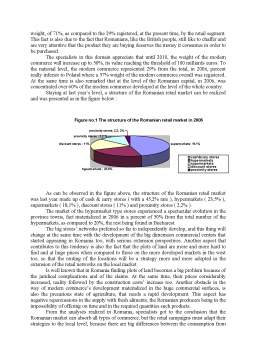Extras din seminar
The modern commerce comes off through the agency of the stores with considerable commercial surfaces and more and more bigger as in the case of the stores of the type hypermarket, supermarket, discount and cash and carry that are the places where the population prefer to do the shopping at the present time.
The hypermarket is a type of store invented in France, in 1963, by the firm Carrefour, being a of sale point that individualizes itself, essentially, through :
- the surface for sale is of over 2.500 mp;
- the size of the assortment of merchandise : between 25 and 50 thousands references, of which 4000 from the food sector;
- the public food sector present with three rooms of consumption : restaurant, home town buffet (cafeteria), snack bar;
- the presence of all departments, even of those that practise the sale through the agency of salesmen ( meat, salami and sausages, cheese, vegetables-fruit ), in the help-yourselves flux;
- a cash register ( at the exit from the help-yourselves flux ) for every 200 mp of sale surface;
- the construction on a single level;
- the settlement, usually, at the periphery of the town;
- the availability of a large parking area ( 1200 parking places on an average ).
In the last few years, the hypermarkets consolidated their “ locomotive “ role in the commercial centers where there are specialized dealers and service bidders. Thus, for example, in a period of 30 years, in France the hypermarket became the most dynamic form of commerce, getting to represent almost 21% of the total sales through en detail commerce. This spectacular dynamic of the hypermarkets was also sustained through the opening, outside France, of numerous of sale unities of French origin. Other European countries know, sometimes under other forms, the “ hypermarket “ phenomenon, starting from 1000 mp, like for example, “ Verbraucher Market “ in Germany.
The increase of the market rate of the hypermarkets is accompanied by a mutation of the concept, characterized through two evolutions :
1. a pronounced bipolarization of the typodimensions of the store : big hypermarkets of over 8000 mp ( Carrefour, Auchan ), considered the most profitable, but with a less rapid evolution because of the lack of the settlement availabilities; small hypermarkets, of up to 5000 mp ( Leclerc, Intermarche ); the last ones are often obtained through the transformation of the supermarkets and have a weight of the nonfood sector sufficiently reduced;
2. a qualitative amelioration of the offer : in order to satisfy the consumers’ needs, that are more and more hard to please, the hypermarkets have the tendency to extend their offers with new products, with services set in the very vicinity, multiplying its efforts in order to make the purchase cadre agreeable. Anyway, the discount prices remain the major axis of the commercial politic of the hypermarket.
Even though, in the last few years, in Romania too, we assist to a real avalanche of supermarkets and hypermarkets, the traditional commerce continues to hold the majoritar weight, of 71%, as compared to the 29% registered, at the present time, by the retail segment. This fact is also due to the fact that Romanians, like the British people, still like to chaffer and are very attentive that the product they are buying deserves the money it consumes in order to be purchased.
The specialists in this domain appreciate that until 2010, the weight of the modern commerce will increase up to 50%, its value reaching the threshold of 100 milliards euros. To the national level, the modern commerce represented 29% from the total, in 2006, percent really inferior to Poland where a 57% weight of the modern commerce overall was registered. At the same time is also remarked that at the level of the Romanian capital, in 2006, was concentrated over 60% of the modern commerce developed at the level of the whole country.
Staying at last year’s level, a structure of the Romanian retail market can be realized and was presented as in the figure below :
As can be observed in the figure above, the structure of the Romanian retail market was last year made up of cash & carry stores ( with a 45,2% rate ), hypermarkets ( 23,5% ), supermarkets ( 18,1% ), discount stores ( 11% ) and proximity stores ( 2,2% ).
The market of the hypermarket type stores experienced a spectacular evolution in the province towns, fact materialized in 2006 in a percent of 50% from the total number of the hypermarkets, as compared to 20%, the rest being found in Bucharest.
The big stores’ networks preferred so far to independently develop, and this thing will change at the same time with the development of the big dimension commercial centers that started appearing in Romania too, with serious extension perspectives. Another aspect that contributes to this tendency is also the fact that the plots of land are more and more hard to find and at huge prices when compared to those on the more developed markets in the west too, so that the renting of the locations will be a strategy more and more adopted in the extension of the retail networks on the local market.
Preview document
Conținut arhivă zip
- The Modern Comerce in Romania.doc













